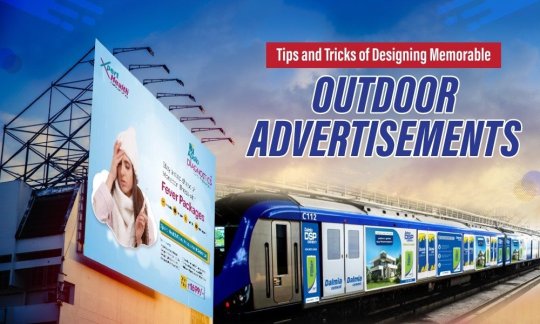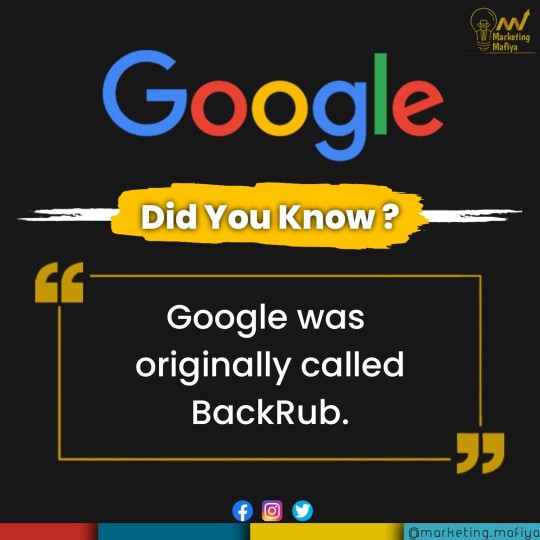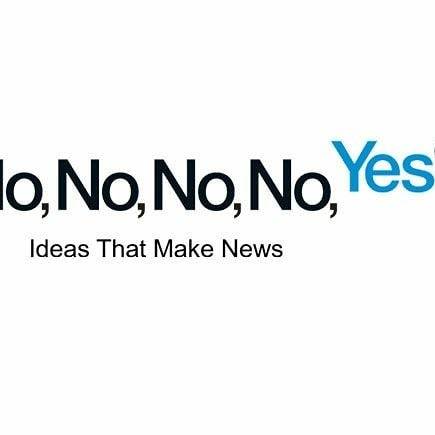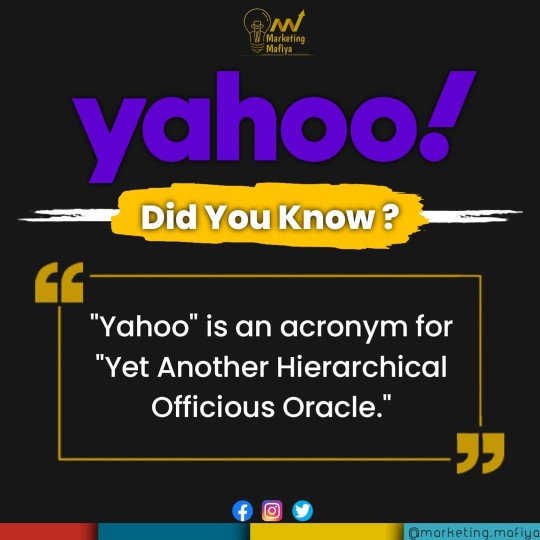#advertisingcreatives
Explore tagged Tumblr posts
Text

Tips and Tricks of Designing Memorable Outdoor Advertisements
Key Elements of Effective Outdoor Advertisements
All forms of Outdoor Advertisements or marketing that are placed outside are referred to as outside marketing. It’s critical to maintain your design clear and straightforward in light of all the things vying for our concentration these days. Ensure the message is prominently displayed by using simple terms, succinct content, and colors with strong contrasts. Funny advertisements have the highest recall factor, according to a study done to address this topic. The knowledge or significance of the content stated in the advertisement came next, and the inclusion of a fascinating protagonist was an additional factor.
Tips and Tricks
Make an appeal with colour
Utilise Illustrations of High Qualities
Explore Innovative Ideas
Notice your brand principles
Keep up with Trends
Hiring an authority
Always Neglect the Specifics
Make an appeal with colour
One of the many effective weapons in the tool kit is color. It has the power to affect someone’s feelings and degree of involvement. To draw notice and make an impact, use color strategically. A sort of advertisement called bus shelter branding is displayed at bus depots and platforms to attract passengers. Transit shelter ads are another name for transit stop ads. They are a powerful tool for businesses to increase revenue and establish their brand. Bus stops allow marketers to directly interact with their intended audience on busy highways because they are frequently found in crowded areas, such as downtown areas, in strategic positions.
Bus shelter advertisements are useful, reasonably priced, and have a wide audience impact. While we recognize that you must adhere to your company’s requirements, you may want to think about highlighting your point of view with a significant portion of brand-appropriate color. Advertisements, concealment, rear ads, seat ads, and LED displays can all be used to mark buses. As an element of their bus advertising, premium bus companies can additionally incorporate staff uniforms, lectures, and tastings. Bus advertising is seen to be a very powerful tool to reach a large audience, considering buses are moving advertisements that are extremely prominent and follow regular schedules. It’s also a clever
way to advertise outside, reaching a broad demographic and helping companies build their brand’s credibility and recognition.
Utilise Illustrations of High Qualities
The technique of placing outdoor advertisements on the back panels of publicly owned buses is known as bus back panel marketing, or bus rear advertisement. Bus back screens are not like regular posters; they pass through crowded urban areas and are seen by many people every day long. Although advertisements placed outdoors are frequently seen from afar, it’s critical to utilize graphics that are sharp and conspicuous. Smaller or smaller photos should not be used since they appear grainy and unpolished. Customized bus back panels with visuals, emblems, slogans, and important messaging provide outstanding exposure and appealing designs. To increase the effectiveness of the marketing, one can also select areas or paths that correspond with your intended audience.
By effectively and economically addressing the intended demographic anywhere they are in the city, bus stations and stations contribute to increased brand presence. There are situations where your only goal in advertising is to raise brand recognition, in which scenario a call for intervention is not required. But when designing your marketing effort, bear in mind that it has a specific objective. Bus stop advertisements offer a high level of visibility and anything for passengers to look at when they’re stuck in congestion, much like other outside marketing formats. Bus advertising is the practice of promoting any business or service on buses, whether they are either public or private. Bus rebranding is accomplished by digital signage mounted inside the buses, rear panel advertisements, advertising on the buses, bus wraps, and advertisements on the seats.
Explore Innovative Ideas
You might want to attract customers to your business, install an app, or visit your website. Federal bus marketing, sometimes referred to as transit marketing, is a method used by companies to advertise on trains and buses. Similar to mobile advertisements, official buses travel the city and target certain populations. Companies can establish connections with prospective clients in various communities and locations thanks to this mobility.
Outside bus advertisements can instantly reach a large audience and provide far more visibility than a typical billboard. Miniature maps and directions are excellent tools for gently nudging motorists and shoppers into your shop. Bus wrapping and bus paneling are two examples of external advertising that can be affixed to the outside of the buses. Bus wraps are expansive commercials that completely envelop the vehicle’s outside appearance, giving plenty of room for colorful and striking images. Larger ads known as “bus panels” are affixed to the exterior and back of buses.
Reflect regarding surroundings
The term “outdoor advertising” describes advertising initiatives that make use of front of the media, including advertisements, transport automobiles, and various kinds of external signage, especially signage outside of companies. Whenever it involves designing your exterior advertisements, don’t be scared to think beyond what is available. Get imaginative with sizes, shapes, and positioning to ensure that your adverts stand noticed if you want to achieve the greatest effect.
Any form of marketing that is utilized to show advertisements outside is often referred to as outdoor advertising. Choices for outdoor advertisements include transportation marketing, street furniture marketing, billboards, posters, kiosks, bus shelters, and other similar choices.
Notice your brand principles
A form of outdoor advertising termed hoarding marketing sometimes referred to as advertising on billboards, employs enormous boards, or hoardings, to show images and commercial text. Building sites are frequently surrounded by signs, which may have imprinted images and patterns on them. In addition, they are visible on the sides of buses, taxis, and structures. A business’s trademark or tagline is usually displayed together with phone numbers in advertising advertisements, which can be stationary or dynamic.
A vehicle or truck is used in mobile van publicity, a kind of widespread advertising, to advertise a service or goods. Winter outdoor advertising should stay clear of employing an excessive amount of white and gray because the gray winter sky will not create sufficient contrast for these designs to stand out.
A method of marketing and promoting material on bus routes and platforms is bus stop marketing, often referred to as transit shelter advertising. Reaching passengers as they go through every day is the aim. Particularly, bus stop advertisements can be an effective means of reaching many people. For instance, the most popular bus shelters tend to be in crowded, central areas with heavy traffic. Bus stations improve traveler safety in several ways. When a bus is turning and not utilizing the curb lane, or when it is at a junction, it pauses, making it unsafe for people to attempt to enter or get off. It is not reasonable for the driver of a bus to search constantly for intended customers.
Keep up with Trends
Flex billboards are used to advertise brands on car-rickshaws as part of a transit advertising strategy called auto advertising, sometimes referred to as auto transport advertising. The whole car or only the side hood might have the ads fastened to them. When it comes to designing an outdoor advertising campaign that works, the small things count just as much as the larger ones. It is important to consider aspects such as font, layout, and branding to ensure that all the components complement one another.
Hiring an authority
When it comes to designing an outdoor advertising campaign that works, the small things count just as much as the larger ones. It is important to consider aspects such as font, layout, and branding to ensure that all the components complement one another. Last but not least, hiring a professional designer is one of the finest ways to guarantee the success of your outdoor advertising campaign. They can guide you through all of these suggestions and more to help you make effective advertisements. Branding on bus shelters can increase ROI and recognize your company. The advertisements are prominently displayed for everyone to observe, and many of those who view them are frequent commuters who pass via these facilities.
Always Neglect the Specifics
It is crucial to recognize the significance of aesthetics when developing effective outdoor advertising initiatives. An effective commercial will draw viewers in, make its point evident, and create a lasting impact. Mobile van marketing used to only use goods or services advertisements, however nowadays, it can also use LED display monitors. Marketing via propellant activity involves attaching lit hoardings, banners, or billboards to a truck or van that travels the city and can be parked at specific locations. Canter van advertising activity is a type of advertising that travels to different locations to promote items or services.
Conclusion
Since it is always visible in public areas and cannot be ignored like online advertisements, outdoor advertising is quite successful. Displays2Go assists companies in taking advantage of this benefit to effectively support their marketing initiatives, reach a large audience, and raise brand awareness. Attracting onlookers’ attention is the main goal of outdoor advertising. Outdoor advertisements employ captivating imagery, striking hues, and astute wording to make an impression on onlookers in the busy cityscape.
#OutdoorAdvertising#DesignTips#MemorableAds#CreativeMarketing#VisualCommunication#BrandAwareness#AdvertisingDesign#MarketingStrategies#BillboardDesign#PublicSpaceAds#EffectiveAdvertising#GraphicDesign#MarketingTips#OutdoorMedia#AdvertisingCreativity#DesignInspiration#BrandVisibility#EngagingAds#MarketingInnovation#AdvertisingSuccess
1 note
·
View note
Text

Tips and Tricks of Designing Memorable Outdoor Advertisements
Introduction
All forms of marketing that are placed outside are referred to as outside marketing. It's critical to maintain your design clear and straightforward in light of all the things vying for our attention these days. Ensure the message is prominently displayed by using simple terms, succinct content, and colors with strong contrast. Funny advertisements have the highest recall factor, according to a study on the topic. The knowledge or significance of the content stated in the advertisement came next, and the inclusion of a fascinating protagonist was an additional factor. For small businesses looking to stand out, exploring new innovative outdoor advertising ideas for small business can help create memorable and effective campaigns
Tips and Tricks
Make an appeal with colour
Utilize Illustrations of High Qualities
Explore Innovative Ideas
Notice your brand principles
Keep up with Trends
Hiring an authority
Always Neglect the Specifics
Make an appeal with colour
One of the many effective weapons in the tool kit is colour. It has the power to affect someone's feelings and degree of involvement. To draw notice and make an impact, use colour strategically. A sort of advertisement called bus shelter branding is displayed at bus depots and platforms with the intention of attracting passengers. Transit shelter ads are another name for transit stop ads. They are a powerful tool for businesses to increase revenue and establish their brand. Bus stops allow marketers to directly interact with their intended audience on busy highways because they are frequently found in crowded areas, such as downtown areas, in strategic positions.
Bus shelter advertisements are useful, reasonably priced, and have a wide audience impact. While we recognize that you must adhere to your company's requirements, you may want to think about highlighting your point of view with a significant portion of brand-appropriate colour. Advertisements, concealment, rear ads, seat ads, and LED displays can all be used to mark buses. As an element of their bus advertising, premium bus companies can additionally incorporate staff uniforms, lectures, and tasting. Bus advertising is seen to be a very powerful tool to reach a large audience, considering buses are moving advertisements that are extremely prominent and follow regular schedules. It's also a clever way to advertise outside, reaching a broad demographic and helping companies build their brand's credibility and recognition.
Utilise Illustrations of High Qualities
The technique of placing advertisements on the back panels of publicly owned buses is known as bus back panel marketing, or bus rear advertisement. Bus back screens are not like regular posters; they pass through crowded urban areas and are seen by many people every day. Although advertisements placed outdoors are frequently seen from afar, it's critical to use graphics that are sharp and conspicuous. Smaller images should be avoided as they can appear grainy and unpolished. Customized bus back panels with visuals, emblems, slogans, and key messaging provide outstanding exposure and appealing designs. To enhance the effectiveness of the marketing, one can also select areas or routes that align with the intended audience. Incorporating innovative outdoor advertising ideas can further elevate the impact and reach of these campaigns.
By effectively and economically addressing the intended demographic anywhere they are in the city, bus stations and stations contribute to increased brand presence. There are situations where your only goal in advertising is to raise brand recognition, in which scenario a call for intervention is not required. But when designing your marketing effort, bear in mind that it has a specific objective. Bus stop advertisements offer a high level of visibility and anything for passengers to look at when they're stuck in congestion, much like other outside marketing formats. Bus advertising is the practice of promoting any business or service on buses, whether they are either public or private. Bus rebranding is accomplished by digital signage mounted inside the buses, rear panel advertisements, advertising on the buses, bus wraps, and advertisements on the seats.
Explore Innovative Ideas
You might want to attract customers to your business, encourage app installations, or drive traffic to your website. Federal bus marketing, sometimes referred to as transit marketing, is a method used by companies to advertise on trains and buses. Similar to mobile advertisements, official buses travel throughout the city and target specific populations. This mobility allows companies to establish connections with prospective clients in various communities and locations. Implementing creative outdoor advertising ideas within transit marketing can further enhance your reach and make your brand stand out in diverse urban areas.
Outside bus advertisements can instantly reach a large audience and provide far more visibility than a typical billboard. Miniature maps and directions are excellent tools for gently nudging motorists and shoppers into your shop. Bus wrapping and bus paneling are two examples of external advertising that can be affixed to the outside of the buses. Bus wraps are expansive commercials that completely envelop the vehicle's outside appearance, giving plenty of room for colorful and striking images. Larger ads known as “bus panels” are affixed to the exterior and back of buses.
Reflect regarding surroundings
The term “outdoor advertising” describes advertising initiatives that make use of front the media, including advertisements, transport automobiles, and various kinds of external signage, especially signage outside of companies. Whenever it involves designing your exterior advertisements, don't be scared to think beyond what is available. Get imaginative with sizes, shapes, and positioning to ensure that your adverts stand noticed if you want to achieve the greatest effect.
Any form of marketing that is utilized to show advertisements outside is often referred to as outdoor advertising. Choices for outdoor advertisements include transportation marketing, street furniture marketing, billboards, posters, kiosks, bus shelters, and other similar choices.
Notice your brand principles
A form of out-of-home (OOH) marketing termed hoarding marketing, sometimes referred to as advertising on billboards, employs enormous boards, or hoardings, to show images and commercial text. Building sites are frequently surrounded by signs, which may have imprinted images and patterns on them. In addition, they are visible on the sides of buses, taxis, and structures. A business's trademark or tagline is usually displayed together with phone numbers in advertising advertisements, which can be stationary or dynamic.
A vehicle or truck is used in mobile van publicity, a kind of widespread advertising, to advertise a service or goods. Winter outdoor ads should stay clear of employing an excessive amount of white and grey because the grey winter sky will not create sufficient contrast for these designs to stand out.
A method of marketing and promoting material on bus routes and platforms is bus stop marketing, often referred to as transit shelters advertising. Reaching passengers as they go through every day is the aim. Particularly, bus stop advertisements can be an effective means of reaching many people. For instance, the most popular bus shelters tend to be in crowded, central areas with heavy traffic. Bus stations improve traveler safety in several ways. When a bus is turning and not utilizing the curb lane, or when it is at a junction, it pauses, making it unsafe for people to attempt to enter or get off. It is not reasonable for the driver of a bus to search constantly for intended customers.
Keep up with Trends
Flex billboards are used to advertise brands on car-rickshaws as part of a transit advertising strategy called auto advertising, sometimes referred to as auto transport advertising. The whole car or only the side hood might have the ads fastened to them. When it comes to designing an outdoor advertising campaign that works, the small things count just as much as the larger ones. It is important to consider aspects such as font, layout, and branding to ensure that all the components complement one another. For those looking to optimize their campaigns, exploring new innovative outdoor advertising tips and tricks, can provide fresh ideas and strategies to enhance visibility and engagement.
Hiring an authority
When it comes to designing an outdoor advertising campaign that works, the small things count just as much as the larger ones. It is important to consider aspects such as font, layout, and branding to ensure that all the components complement one another. Last but not least, hiring a professional designer is one of the finest ways to guarantee the success of your outdoor advertising campaign. They can guide you through all of these suggestions and more to help you make effective advertisements. Branding on bus shelters can increase ROI and recognize your company. The advertisements are prominently displayed for everyone to observe, and many of those who view them are frequent commuters who pass via these facilities.
Always Neglect the Specifics
It is crucial to recognize the significance of aesthetics when developing effective outdoor marketing initiatives. An effective commercial will draw viewers in, make its point evident, and create a lasting impact. Mobile van marketing used to only use goods or services advertisements, however nowadays, it can also use LED display monitors. Marketing via propellant activity involves attaching lit hoardings, banners, or billboards to a truck or van that travels the city and can be parked at specific locations. Canter van advertising activity is a type of advertising that travels to different locations to promote items or services.
Conclusion
Since it is always visible in public areas and cannot be ignored like online advertisements, outdoor advertising is quite successful. Displays2Go assists companies in taking advantage of this benefit in order to effectively support their marketing initiatives, reach a large audience, and raise brand awareness. Attracting onlookers' attention is the main goal of outdoor advertising. Outdoor advertisements employ captivating imagery, striking hues, and astute wording to make an impression on onlookers among the busy cityscape.
#OutdoorAdvertising#MemorableDesign#AdvertisingTips#CreativeAds#DesignTricks#VisualMarketing#BrandAwareness#EffectiveAdvertising#MarketingStrategies#BillboardDesign#PublicSpaceAds#EngagingContent#AdvertisingCreativity#DesignInspiration#MarketingTips#OutdoorMedia#BrandVisibility#InnovativeAds#AttentionGrabbing#DesignSuccess
0 notes
Photo

VIRTUAL EVENT INDONESIA Dancer by FOREVER DANCE CREW Need a dance number for your videos???Just give us a call. We will provide dancers and costumes for you. #digitalcontent #advertising #marketingcontent #marketingideas #videocontent #videocontentmarketing #dancecontent #advertisements #advertisingcreative (at Forever Dance Center) https://www.instagram.com/p/CGXJvtGAVxU/?igshid=en9o5dbasdll
#digitalcontent#advertising#marketingcontent#marketingideas#videocontent#videocontentmarketing#dancecontent#advertisements#advertisingcreative
0 notes
Text
Sectors and Job Roles within Creative Industries
In the current times we live in, the creative industries are more vital than ever. More than two million people were found to work in the creative industries and that number was growing - already up more than a third since 2011 - prior to COVID-19. All these figures demonstrate that this had become a vibrant sector with lots of opportunities for graduate careers. The industries growth over recent years has been driven by a blast in computer services, highlighting the importance of digital creative industries.
Here are some of the employment opportunities within the creative industries:
Advertising

Creative development professionals put together the visuals for online advertisements, magazine and newspaper advertisements, television advertisements, or brochures and corporate reports. Workers with these jobs tend to have strong attention to detail and communication skills, as well as creativity and training in the specific disciplines required.
Advertising copywriters write print ads, online ads, brochures, or commercial scripts for a variety of ad mediums, and also need to be able to spot spelling and grammar errors easily. Graphic designers create visual concepts, by hand or using computer software. Both tend to work under a creative or art director.
Job Roles -
Copywriter
Editorial photographer
Art/Creative director
Creative technologist
Editor
Graphic artist/designer
Writer
Producer
Illustrator
Creative Director - duties and responsibilities:

An Art Director or Artistic Director designs the visuals for advertising campaigns, publications, films and other projects. Their duties include creating visual concepts, illustrating these concepts and managing their development.
Collaborating with clients and relevant employees, such as the Creative Director, Writer or Marketer, on design concepts
Creating sketches or storyboards of design concepts
Presenting sketches and concept ideas to clients, the Creative Director, accounts teams and other relevant parties
Hiring creatives, such as Graphic Directors or Photographers, to develop design concepts
Selecting and booking locations and studios, as required
Overseeing creatives to ensure they work productively and meet the brief and budget
Maintaining graphic consistency across all deliverables
Reviewing graphic materials to assess its validity and appropriateness for the brand
Making changes directed by clients and overseeing edits
Arts and Culture Sector

Arts and culture, including museums and libraries, make a substantial contribution to the UK and local economies
Culture also has a wider growth impact, through making places where people want to live, work, visit and invest. Culture is what makes a place distinctive.
A strong cultural offer attracts high skilled workers and retains graduates. This in turn attracts firms and boosts business investment across sectors, increasing employment opportunities. There is evidence that the cultural offer is a significant pull factor in the location decisions of businesses, but particularly in creating clusters of creative industries.
Job Roles -
Art gallery manager
Performing artist
Illustrator
Tattoo artist
Curator
Museum Curator

A commercial art gallery manager is responsible for the commercial and artistic success of a gallery. They manage the sales and marketing activities of running a commercial art gallery and communicate directly with artists and dealers.
A key aspect of the role will be selecting art and artists, to both enhance the gallery's reputation and bring in money from artwork sales. They can work underneath the gallery director or owner but still have responsibility for the commercial and artistic success of the gallery.
Museum curators are responsible for caring for the museum’s collection. They seek to preserve, archive, maintain, study, and display the museum’s collection in an interesting and accurate way. In addition, they add to or change the collection by either buying new pieces or trading artefacts with other museums. Beyond working with the museum’s collection directly, curators support staff in the care of these components and educate the public about different items.
assess and select artwork
maintain ongoing promotion and advertising of the gallery liaise with framers, liaise with visiting artists and negotiate sales
promote and sell artists' work, through both exhibitions and personal contacts
catalogue acquisitions and keep records and archives
plan, organise, present and market exhibitions and shows, including responsibility for public relations
work closely with individual artists, develop relationships with new artists, and extend relationships with established artist connections
promote exhibitions and work by individual artists
curate shows in cooperation with artists and technicians
arrange transportation of work to and from the gallery, both nationally and internationally
organise equipment hire and ensure correct installation of the artwork
negotiate with gallery managers and curators from other galleries to arrange for loans
develop client lists by notifying potential clients of particular works and exhibitions, according to their interests
extend the client database
develop and update the gallery website
keep up to date with industry developments and market trends
Design

A designer plays a key role in a creative company. Using elements like typography, illustration, photography and layouts, a designer always has an extremely creative mind that can absorb visual trends and deploy them in fresh and exciting ways.
Communication is an important part of the job, as designers work with both management and clients to formulate campaigns that meet specific objectives. The professional opinion of a designer is highly sought after during the construction of campaigns, so the confidence to guide people effectively is often required.
Typical activities - each designer’s role varies from employer to employer, but common activities include:
Staying up to date with industry trends to keep ahead of competitors
Producing consistently excellent visual work
Producing a host of ideas, selecting the best ones and selling them to the other members of the team and to clients
Encouraging others to share their ideas and nurturing creativity
Communicating productively with management and clients to keep them up-to-date with project milestones
Creating direction for projects and guiding team members
Job roles -
Costume designer
Graphic designer
Set design
Jewellery designer
Hair and makeup designer
Interior designer
Fashion Industry

Fashion careers require creativity and an understanding of different types of clothing. The type of creativity used varies depending on the specific job. A fashion designer needs to be artistically creative, while a technical designer uses creativity in engineering. Most importantly, a passion for style is necessary to excel in the fashion industry.
Job Roles -
Fashion Designer
Textile designer
Garment technologist
Illustrator
Stylist
Pattern cutter
Visual merchandiser
Graphic designer
Fashion photographer/filmmaker
Trend forecaster
Costume designer
Studio manager
Copywriter
Social media assistant
Event manager
Art director
Tailor
Fashion Illustrator

Illustrators work closely with fashion designers to discuss their requirements and create conceptual sketches and illustrations of their products. This could involve using computer-aided design software, painting and/or free-hand sketching.
Many fashion illustrators work freelance, for various companies, design studios or retailers as it is competitive. Illustrators must be able to present detailed artwork of a very high standard. They may use drawing, painting, collage, and stencilling or image manipulation software in order to do this. Some work as forecasting illustrators for prediction services, when predictions have not yet been realised and photographs cannot be used. A fashion illustrator will work at creating accurate images using ideas, representing a diverse range of products. In general, as a fashion illustrator you would work closely with fashion designers and art directors to produce artistic, unique and creative visual images with the aid of traditional and digital media. The images created by fashion illustrator professionals are commonly integrated in print ads, television commercials, and online advertisements.
Typical Duties
Create designs for garments, shoes, fashion accessories, and other apparels with the use of imaging software programs like Photoshop and Illustrator
Bring the vision of the fashion designers to life through the illustration of the actual design plan
Sketch drawings using various mediums including paint, charcoals, coloured pencils, and computer software programs
Produce drawings and layouts that will be used in catalogues, magazines, brochures, flyers, commercials and other advertising media
Communicate fashion ideas through sketches, layouts, drafts and drawings
Select the appropriate colour, sound, and animation that will go well with the existing fashion concept
Develop fabric patterns and designs that will be used for manufacturing garments and wardrobes
Maintain open communication with the fashion designers, art directors, and buyers
TV and Film

A career in film, TV and video production gives you the chance to showcase your creativity, use your technical skills and work in a closely-knit team. It can be exhilarating to know that you’re involved in producing something that’s going to be seen by others – maybe even something award-winning.
Careers in this area also mean plenty of variety and suit people who want a changing work environment, as you can move between very different projects: for example, you might work on a noir short film, a music video and a nature documentary within the course of a few months.
It would be impossible to name every job title in the film industry so here’s just a few of the key job roles part of the team -
Director
Producer
Broadcaster
Digital imaging technician
Director of photography
Lighting technician
Sound mixer, Script supervisor
Hair/costume design
Makeup artists
Set decorator
Editor
Colourist
Post production supervisor
Music editor
Screenwriter
Set Designer/Decorator
A Set Decorator visually interprets the personality of a film or television show from script to screen through set decor. Set Decorators carefully decipher the psychology and taste of the characters which allow them to select, procure, fabricate, layer, mix, and match furniture, curtains, carpets, artwork, wallpaper, and other items that may denote character and/or plot while they also factor in the schedule and other practical considerations like stunts and visual effects, for example.
Working above the Set Decorator in the filmmaking hierarchy is the Production Designer who begins collaborating with the Director, and Director of Photography to decide the overall look and vision of a project from the very beginning. Set Decorators then work in very close partnership with the Production Designer to help achieve that vision physically through furnishings and set decor. This does not include the structure or architecture of each set.
While Set Decorators do not function independently it is important to note that the Set Decoration Department as a whole is an independent entity with great creative and pragmatic responsibilities.

The Shape of Water (2017) Academy Award Winners for Best Production Design
Set Decoration is the department that works for and with the Set Decorator. The Set Dec team gets the job done on the ground– sourcing, creating, and procuring furnishings and dressings as well as skilfully placing and arranging them on set amongst many other duties well before the shooting crew arrives. The team seamlessly works together while simultaneously collaborating with many other departments. We’ll go into each position in more detail below, but first we have a few notes.
The Set Decorator, as the head of the Set Decoration department, is responsible to the Production Designer, or the Art Director, the Director, the Producer, and the Production Manager.
This creative is in charge of the decoration, coordination, and realisation of the dressing of all decor, the procurement or fabrication of any and all set dressings, as well as the storage, movement, preparation and placement of all dressings within all studio and location sets. The maintenance, replacement and listing of all dressing inventory are also under their purview.
The Set Decorator also monitors the dispersal of the approved set decorating budget, delegates work to the set decoration team as necessary for the efficient operation of the department, and completes each decorated set, camera-ready, before the shooting crew arrives or as required of the production schedule.
Making of the Shire

In March 1999, Sir Peter Jackson’s crew began the nine month quest to bring the ideas for Hobbiton to fruition; help was provided by the New Zealand Army, and soon 39 temporary Hobbit Holes were scattered across the 12 acre plot used for the set. He had to cover all the details down to the tiniest. Secrecy was key, and strict security measures were put in place by the production company throughout construction and filming. Filming commenced in December 1999, and it took around three months to get a wrap on The Shire.


To ensure the setting was perfect, they planted vegetables and flowers a year before filming began. Lord of the Rings set new standards in the film industry: it changed the way people think and its ideas are used to this day. It was a visual masterpiece from the hobbit town to abandoned castles – viewers were treated to some very remarkable scenes.

The original Shire, constructed of polystyrene and plywood, was torn down after the completion of The Lord of the Rings trilogy. It was never meant to be a permanent set. But when they began rebuilding Hobbiton for The Hobbit movies in 2010, they decided to make the homes more permanent. Using concrete, wood and bricks, it took 70 set builders to complete 44 reconstructed Hobbit Holes in the same fantastic destain seen in the films.

Since the filming of The Lord of the Rings trilogy and The Hobbit trilogy, Hobbiton has become New Zealand’s biggest tourist attraction. The hyper realistic movie set designed by Sir Peter Jackson’s production team makes travellers feel like they’re in the heart of Middle Earth.
Publishing

Publishers set the editorial and commercial direction for companies that publish books, newspapers, magazines and content in print and online.
A publishing company requires people with a range of skills to commission manuscripts for books, magazines, academic papers and online content, prepare the material for publication and take it to market. Depending on the size of the company, a publisher may employ full-time staff to carry out jobs such as copy editing, proofreading and design, or it may hire freelancers for individual projects. At its most fundamental, publishing is simply making concepts public. It’s about communicating ideas, making connections, linking people who are creating content with people who need that content. The information economy is powered by ideas, and publishers are at the heart of getting those ideas out to the world and in a way that will have the most impact.

People are viewing all sorts of content online, on their smartphones, e-readers and tablets. Magazine and newspaper publishing are linked to journalism. The range of jobs is very wide, from working directly with authors through designing and illustrating, editing and proofreading, marketing and sales, production and distribution, to creating video and audio. Competition is fierce. People start at the bottom and work their way up. Many people applying for jobs will have a degree.
There has been an increase in demand particularly for the book publishing industry since the global pandemic began.
Careers in publishing include -
Agenting
Audio
Audience and digital development
Marketing and communications
Design
Editorial
Production
Publicity
Rights
Sales
Commissioning editor
Writing
Music and Performing Arts
Performing arts are creative arts that are performed by individuals or groups in front of a live audience. Instrumental music, vocal music, dance, and theatre are included in the performing arts industry and they are an intrinsic part of cultures around the world. The performing arts date back to ancient Greece, when plays, comedies, dances, religious rites, and other forms of entertainment and education were performed before live audiences in theatres and arenas.
Musicians and singers perform before live audiences in theatres, concert halls, arenas, and clubs. They also record their performances in recording studios. The type of music they perform depends on their interest and specialty: It may be rock, hip-hop, jazz, classical, opera, or other. Musicians and singers perform solo or in orchestras, choruses, bands, or other types of music groups. They may provide background music for plays. Singers may provide background vocals for lead singers in bands. Musicians and singers perform music that has already been written and they may also write their own music.

It may be classical or popular; it may stem from a particular culture’s history and rituals. It may be instrumental, with an orchestra performing classical pieces, or it may be a band with guitars, drums, and singers, or any combination of instruments and vocalists. Dance may also be classical, such as ballet, or modern. There are also religious dances, and dances that celebrate hunting, warfare, harvests, and other aspects of life in earlier times.
This art form can enhance the creativity of a person. It can also improve social skills, language, and reading skills. Critical thinking skills are also learnt through this. We can call music a universal language. Everybody listens and enjoys music. It is also tightly associated with dancing. Music provides the rhythm and it makes dancing possible and better.

Dancers express stories and ideas through the movement of their bodies. There are a wide variety of types of dance, from ballet and tango to modern dance, tap, jazz and more.

Dancers usually perform as part of a performing arts group such as a ballet troupe. They perform in front of live audiences in theatres; some shows are performed in studios for TV broadcast. Casinos, theme parks, and cruise ships also employ dancers, musicians, singers, and other performing artists for shows.

Dance generally refers to human movement, goes with a rhythm of music and used as a form of audience entertainment in a performance setting. Choreography is the art of making dances, and the person who practices this art is the choreographer.
Musical accompaniment, the moves, and how the dancers portray their emotions is a great part of the performance; body movements are not the only important matter in this kind of art. Dancing is not only learning the steps; it is also a way of moving that uses the body as an instrument of conveying feelings.

Theatre performances may feature acting, singing, dance, music, puppetry, pantomime or opera. Many artists contribute to the performing arts, including costume designers, prop designers, theatre designers, choreographers, creative directors and others.
Actors portray characters written by writers for theatre, film, television, and other performing arts media. They also act in roles for video, radio, and other settings for entertainment and information. Some roles involve dancing, singing, or playing a musical instrument. Actors use speech, gestures, and body movements to interpret serious or comic roles to entertain or educate audiences. They work independently and also as part of casts in shows, sometimes touring the country or traveling to other parts of the world to perform. They may work indoors in theatres or in outdoor venues also.
Job opportunities in this sector include:
Dancer
Screenwriter
Theatre director
Actor
Musician
Choreography
Art administrator
Stage Manager
Music Journalism
Broadcaster
Music production
Sound technology
Games Design and Digital Media

Game designers are the centre of creativity at the heart of producing a new game. Game designers create the concepts and worlds of video games. They are involved with the design of the genre, environment, story, characters, gameplay system, objectives and user experience of video games.
A Game Designer is the creative force behind the development of a video game. They are the originator of the game concept and will develop it through to its final release. Game Designers author the storyline, writing the plot points, character development, and game objectives that drive the game. The designer will work within the rules of the genre of the game, with real innovation occurring when the genre is pushed to its limits or reinvented.

Game Designers establish the aesthetics, mood and look of the game which is integral to the game’s individual appeal and marketability. The user experience must always be considered during the development process, as players need to feel engaged and rewarded by the game to continue playing.
The game development process is all about teams from different disciplines (creative and technical) working in tandem and communicating their requirements to each other. It is the Game Designer’s job to ensure that teams and team dynamics work effectively to finish on schedule and on budget.
Game Designers are charged with developing game concepts whether they be their own original idea, a commissioned idea or a game based on another medium such as a film.
Whatever the scope of the task, the role of the Game Designer requires a mix of creative, managerial and technical responsibilities.
They may be expected to deliver the following in this job role:
Design and develop the original concept
Programming
Construct level structure
Write storyline, character bios, dialogue, plot points, game objective
Storyboard the action of the game
Conceive every element of the game including rules, setting, objects, vehicles, weapons, flora, fauna - visual effects artist
Direct action sequences
Define user interface, menus and controls
Generate the Game Design Document (GDD)
Develop early prototypes
Decide on the devices and platforms on which the game is played
Define the user experience
Work with programmers to design the back end of the game - graphics programmer
Research target audience to understand what they want in the game
Create storyboards and write scripts
Lead the development process
Produce sound effects, dialogue, musical score, sound mix and sound edit - music composer
Manage quality assurance testing, and follow up on feedback - games tester
Oversee the marketing and distribution roll-out
Ongoing development and versions of the game
Digital Media
The world we live in today is populated by digital media products, and these products enable and deliver experiences in many industries, including industries that aren’t typically associated with digital media—such as health, government and education.

In the current times we live in, digital media within and out-with the creative industries is more vital than ever.
A weather app on a smartphone, a racing game on a video game console and an ultrasound imaging device in a hospital are all digital media products. They are successful because they are engaging, easy to use (even fun in the case of games), and deliver results. Digital Media is a blend of technology and content, and building digital media products requires teams of professionals with diverse skills, including technical skills, artistic skills, analytical and production coordination skills. All of these skills need to be balanced on a team, with all team members focused on creating the best user experience.

Organisations that build digital media products rely on multi-skilled teams and manage those teams with business processes designed to enhance their efficiency and effectiveness.
Digital media products can be found in:
eCommerce
Games – console, online and mobile
Websites and mobile applications
Animation
Social media
Video
Augmented reality
Virtual reality
Data visualisation
Location-based services
Interactive Storytelling
Digital media can include these industries:
Entertainment
Technology
eCommerce
Non-Profit
Health
Education
Marketing and advertising
Government
Sports
Environment
Television
Publishing
0 notes
Photo

Ye pata tha aapko... Share to your friends... . . . @marketing.mafiya . @marketing.mafiya . @marketing.mafiya . . . #marketing360 #MarketingStudent #marketingfacts #marketinginstagram #MarketinginVenus #marketinglovers #marketingcollateral #AdvertisingContent #advertisingcreatives #AdvertisingDar #advertisingdisplay #advertisingdoneright #Entrepreneurships #entrepreneurshipquotes #Entrepreneurism #entrepreneursship #businesslady #businessbabe #businesslifestyle #businessmind #businesspartners #motivationalposts #motivationday #motivationthursday #motivationsunday — view on Instagram https://ift.tt/3yGACFd
0 notes
Photo

Steffan MacMillan
Typographer, Illustrator, AdvertisingCreative, Copywriter, Dad of 3, Rhondda Gent, London desk.
Official site
1 note
·
View note
Link
Hey r/Entrepreneur, I'm Anthony from The Product Person 🛠️I summarize an article every week that'll 10x your product skills.Today I'm summarizing a 23-page Harvard paper on consumer attention titled, “The Rising Cost of Consumer Attention: Why You Should Care, and What You Can Do About It” by Thales S. Teixeira.Hope you enjoy. Send me your feedback on Twitter @antdke----------------Why you should care about what the consumer wantsI’m about to say some very basic conceptual stuff that you should probably know by now. People won’t buy what you’re selling if they don’t know it exists. See, basic. You have to be able to capture attention and redirect it to what you want to sell. Without at least some attention from your end consumer, then your marketing effort will be for naught.For a long time, marketers have been following 2 questions when it comes to promoting a product:How to capture attention?How to convert that attention into behavior towards a product/brand?However, many marketers start this process assuming that attention is a given. That they’ve earned the consumer’s attention just by existing as a brand for the consumer to buy. Wrong. Very Wrong.Here’s another basic concept, disregarding what pique’s a particular consumer’s interest in the process of trying to gain their attention will cause them to neglect you as a brand. The longer it takes for you and your marketing team to realize this, the longer you’ll be shoveling ad money into a furnace (That money would probably be put to better use in that furnace anyway).But to finish off the point, yes, Garyvee is right. First, you must empathize with your audience/the consumer and focus on what they believe to be important. Only after that, should you focus on your own selfish, persuasion-related goals.To put it simply, the more you care about the end consumer the less money you’ll spend on selling to them.Caring about the consumer’s interests == Spending less $$ to get their attentionAttention always comes at a priceTwo ways to capture attention in advertising:Paying for itPaying media & social media companies to get a TV spot, newspaper or magazine page, spot on the newsfeed, etc. (The costs are relative to audience sizes and are referred to as CPMs—cost-per-thousand-impressions; CPMs just means “cost”.)Earn it (Indirectly pay for it)Creating compelling enough content that people seek out your brand organically through Google, YouTube, or social media. Content can cost tons of $$$ to create and distribute.Why costs are increasing while attention is decreasingHere are 3 results from studies done with TV ads that should help you understand why this is happening:From 1966 to 1998, inflation of the US Dollar and CPMs for a primetime TV ad and a Super Bowl ad were around the same values. In 2010, Super Bowl and primetime TV ad costs had skyrocketed 6x and 5x, respectively, since its 1966 prices. All while inflation has only grown 3x.In 2013, the average American was exposed to roughly 52,000 TV commercials.From 1988 to 2012, there’s been a consistent downtrend in the % of people that paid attention to ads. “Not paying attention” means changing channels with a remote, skipping with a DVR, or mentally tuning out by focusing on something else. The percentage of people that viewed ads completely was at 97% in the early 1990s. That percentage is now less than 20% in 2012.Attention has 2 dimensions: intensity (quality) and duration (quantity). So far, we know that the quality of attention is decreasing while prices are rising. A knee jerk reaction to this trend is that marketers seek to increase their ad spend as prices rise to counteract the drop in quality. I’ve decided to term this as “The Marketer’s Dilemma”.The Marketer’s Dilemma is basically that the number of marketers buying ads and the number of ads being created are increasing much faster than the amount of attention available to capture. More ads mean more things shouting at consumers to buy. This leads to consumers paying less attention to ads. This decline of attention quality causes marketers to up their ad spend to grab more attention. Then ad costs swell as demand skyrockets in comparison to the fixed amount of attention available.Why attention is decreasingAd content serves 2 purposes to consumers: information & entertainment. And today all the information you can ever need is easily accessible on the internet. A brand’s website serves all the informational value that a consumer needs on a brand.Meaning, a consumer would rather Google “Ford latest cars” than watch a 30-second ad spot by Ford detailing specific upgrades in their new models of cars. So these days, brands are more inclined to provide entertainment in their ad content.What companies have been doing about the rising costsThere are 2 general tactics that companies have been using to counteract the drop in attention quality:Increasing the amount of entertainment in their adsOffering consumer promotionsEntertainmentA quick study of 60 TV ads from the 1950s to the 2000s found that the amount of time that brands spend on the entertainment value in the ads has more than triples from 13% to 40%.PromotionsThese usually take the form of coupons, daily deals, rebates, and short-term price discounts. Consumers may hate ads but they still love a good deal.In 2000, American companies spent an equal $300 billion on advertising and promotions. In 2013, promotion spending ($630 billion) is now 2.5x larger than advertising spending ($260 billion). Largely thanks to online daily deal sites like Groupon.While offering consumer promotions does have a positive effect on short-term sales, it does not carry over into future sales and generally does not create a great perception by consumers of your brand. People stop buying once the sale stops. Thales’ proposed solution: The Attention-Contingent Advertising Strategy (ACAS)ACAS involves 4 steps:Define the purpose of your marketing communication to determine the quality of attention that you need. (Necessary attention)With the help of people that control the channels, you want to market in (TV networks, magazine companies, etc), determine the available quality of attention of your target audience in those channels. (Available attention).Choose the appropriate advertising strategy to match the quality of attention available. (The contingency).Create the ad content. But before creating the ad, the quality of attention needs to be determined.There are 4 levels of quality when it comes to attention and for each level, there’s a strategy to go about obtaining it.Full, undivided attentionWhat to do: Focus on persuasion.Traditional ads that focus on imagery work here.**Partial, divided attention to a main screen (**Ex. Person not paying attention to the game on TV because they are multitasking )What to do: Don’t lose attention.Ads should be focused on triggering immediate actions and emotions.Partial divided attention to a secondary screen (Ex. Person scrolling through Instagram while watching the game on TV)What to do: Win the competition for attention.Entertainment works here. But not too much as to dilute the persuasion.Near to complete lack of attentionWhat to do: Grab the attention of the small subset of consumers that are paying attention and then get to other via viral sharing.Thales explains how to deal with the 4 levels of attention quality. He suggests 3 options:Lean AdvertisingCreating ads to work under low levels of attentionDeveloping ads that increase the level of attentionLean Advertising (Buying cheaper attention)Lean advertising is rapidly building a brand on a limited budget. An ad campaign involves two tasks: content creation and distribution. And with lean advertising, your efforts are quick & low-cost, but not low-value.Companies can have successful campaigns for 10% or even 1% of what they would’ve spent using traditional ad agencies. If you’ve ever consumed Gary Vaynerchuk’s content, it’s pretty much the essence of lean advertising. You can do this by:Creating content yourselfOutsourcing content creationDistributing content yourselfOutsourcing content distributionCreating ads to work under low levels of attentionContrary to belief, people still watch TV. However, they aren’t as attentive. As much as 40% of the time watching TV is spent also multitasking on other media devices. This presents a new opportunity for marketers: ads can be used to redirect people from what they’re watching to other platforms like a company’s website or to make an online purchase.Thales performed a study to put this to the test. He built a dataset of 1400 unique ads of 22 brands that aired more than 374k times on various programs and TV channels during 2010, the year tablet sales skyrocketed. And to measure the effect of TV ads on online behavior immediately after an ad was aired, he matched TV advertising data with website visits and online purchases of 100,000 participants on a second-by-second basis.Results:Ads focused on strong visual imagery are the least effective in terms of driving online purchases.The best ads are action-focused ads. (CTAs work!) Ads that urge people to go online, vs ones that don’t, actually accomplish this to a great extent.No single ad can accomplish both tasks of increasing the number of visitations to the website and the number of purchases.Product-focused ads and emotion-focused ads increase online purchases but result in fewer total visits to the website. Emotion is slightly more effective.A focus on product or brand can be persuasive when consumers eventually decide to shop, but it does not motivate multitaskers to act/shop impulsively.If marketing to a multitasking audience, don’t use imagery focused ads.Action-focused ads work regardless of industry.Lower attention isn’t necessarily bad as long as the right ad content gets to the right audience and you’re able to redirect attention where you want to redirect it to. Whether that be other content or an online purchase.Developing ads that increase the level of attentionAs a marketer, you need to stretch the current attention that you receive to create virality and increase attention.In a study of 82 ads for beverage, confectionary, and alcohol brands. Thales tests whether someone fully watches an ad based on if they are “entertained”. In the test, Thames records the viewers’ reactions to the entertainment and uses face-tracking technology to detect grins, smiles, and laughter.Results:As you might assume, the more a viewer was entertained the more they were likely to watch an ad until the end.A more interesting find, the more they were entertained, the higher their intent to purchase the product but only up to a certain point, after which more entertainment led to fewer purchases.Using entertainment to create more engaging TV ads always helps to attract attention but deters persuasion after some point. The attention to the entertainment competes with the attention to the brand message.Thales also conducts a similar study to understand why content gets shared and why certain ones go viral. Similar to the previously mentioned study, Thales shows a sample of ads to consumers and used face-tracking to read the reactions to humor by tracking expressions of joy and surprise. There was also a personality questionnaire taken before the ads. For each ad, they were allowed to view or skip it, and if they viewed, they could share the ad with a few (termed selective sharing) or multiple (termed broad sharing) acquaintances.Results:Unsurprisingly, ads with a known brand are more like to be viewed.Ads with an unfamiliar brand are just as likely as a familiar one to be shared if it gets viewed.Feelings of joy & surprise are important to explain why people view as well as share.Personality has a strong influence on sharing, especially broad sharing. Extroverted and self-directed (people focused on themselves as opposed to others) are more likely to broadly share ads.The ads most shared had a special characteristic: they used content that enabled the self-interested person to benefit personally and gain some element of social capital from the act of sharing in 4 ways:To communicate their values to others.Create a tribal community on an inside joke.To be seen as someone with privileged access to good content.Even to show that they were the center of attention.If you want to create virality, always ask, “what can the end consumer/my audience/someone achieve if they share the advertisement?”Thales terms the process of creating content that allows for the mutual benefit of both consumer and the advertiser as “advertiser symbiosis”.In advertiser symbiosis, the marketer has to understand the consumer’s needs and create content that allows the consumer to benefit personally. But remember, brands must remain self-interested by making sure they achieve their goals of persuasion or else they risk providing free entertainment for audiences that will never consider their products.--------------Enjoyed this article summary? You can get one every week to your inbox, subscribe to The Product Person here.Enjoy the rest of your Friday :)
0 notes
Photo

Gideon Amichay's⠀ AAAAAAmazingGGggggg⠀ https://buff.ly/2HKjNRY⠀ ***⠀ #advertising #advertisinghistory #advertisings #AdvertisingSupport #advertisingcrate #advertisingphoto #advertisinghotel #AdvertisingAgencyFinancing #advertisingtrend #advertisingfail #advertisingbh #advertisingangency #advertisingtoy #advertisingcake #advertisingposter #advertisingspecialty #AdvertisingDesign #AdvertisingClock #advertisingaustralia #advertisingsecrets #advertisingcreatives #advertisinghelpneeded #advertisingpics #advertisingvideo #advertisinglethbridge #advertisingcollectables #advertisingmelbourne #AdvertisingForAll #advertisingvideography #AdvertisingCampaign
#advertisinghotel#advertisingsupport#advertisingcampaign#advertisingaustralia#advertisinghelpneeded#advertising#advertisingpics#advertisingspecialty#advertisinghistory#advertisingbh#advertisingmelbourne#advertisingposter#advertisingcollectables#advertisingdesign#advertisingforall#advertisingvideography#advertisingclock#advertisingsecrets#advertisings#advertisingcake#advertisingphoto#advertisingcrate#advertisingvideo#advertisingfail#advertisingangency#advertisinglethbridge#advertisingtoy#advertisingagencyfinancing#advertisingtrend#advertisingcreatives
0 notes
Photo

VIRTUAL EVENT Indonesia Dancer Indonesia by FOREVER DANCE CREW Need a dance number for your videos???Just give us a call. We will provide dancers and costumes for you. #digitalcontent #advertising #marketingcontent #marketingideas #videocontent #videocontentmarketing #dancecontent #advertisements #advertisingcreative (at Forever Dance Center) https://www.instagram.com/p/CGUtFGQgtQq/?igshid=h6w26vi5m2rq
#digitalcontent#advertising#marketingcontent#marketingideas#videocontent#videocontentmarketing#dancecontent#advertisements#advertisingcreative
0 notes
Photo

Are u able to pronounce the full form of YAHOO! . . . @marketing.mafiya . @marjeting.mafiya . @marketing.mafiya . . .#marketing360 #marketingjobs #MarketingStudent #marketingfacts #marketinginstagram #Marketingdeafiliados #MarketinginVenus #marketinglovers #marketingcollateral #AdvertisingContent #advertisingcreatives #marketingmafiya #advertisingdisplay #Entrepreneurships #entrepreneurshipquotes #Entrepreneurism #entrepreneursship #businesslady #businesslifestyle #businessmind #businesspartners #motivationalposts #motivationday #motivationsunday #MotivationalPic — view on Instagram https://ift.tt/3oy51kt
0 notes
Link
Hey r/startups, I'm Anthony and I'm summarizing a 23-page Harvard paper on consumer attention titled, “The Rising Cost of Consumer Attention: Why You Should Care, and What You Can Do About It” by Thales S. Teixeira.----------------Why you should care about what the consumer wantsI’m about to say some very basic conceptual stuff that you should probably know by now. People won’t buy what you’re selling if they don’t know it exists. See, basic. You have to be able to capture attention and redirect it to what you want to sell. Without at least some attention from your end consumer, then your marketing effort will be for naught.For a long time, marketers have been following 2 questions when it comes to promoting a product:How to capture attention?How to convert that attention into behavior towards a product/brand?However, many marketers start this process assuming that attention is a given. That they’ve earned the consumer’s attention just by existing as a brand for the consumer to buy. Wrong. Very Wrong.Here’s another basic concept, disregarding what pique’s a particular consumer’s interest in the process of trying to gain their attention will cause them to neglect you as a brand. The longer it takes for you and your marketing team to realize this, the longer you’ll be shoveling ad money into a furnace (That money would probably be put to better use in that furnace anyway).But to finish off the point, yes, Garyvee is right. First, you must empathize with your audience/the consumer and focus on what they believe to be important. Only after that, should you focus on your own selfish, persuasion-related goals.To put it simply, the more you care about the end consumer the less money you’ll spend on selling to them.Caring about the consumer’s interests == Spending less $$ to get their attentionAttention always comes at a priceTwo ways to capture attention in advertising:Paying for itPaying media & social media companies to get a TV spot, newspaper or magazine page, spot on the newsfeed, etc. (The costs are relative to audience sizes and are referred to as CPMs—cost-per-thousand-impressions; CPMs just means “cost”.)Earn it (Indirectly pay for it)Creating compelling enough content that people seek out your brand organically through Google, YouTube, or social media. Content can cost tons of $$$ to create and distribute.Why costs are increasing while attention is decreasingHere are 3 results from studies done with TV ads that should help you understand why this is happening:From 1966 to 1998, inflation of the US Dollar and CPMs for a primetime TV ad and a Super Bowl ad were around the same values. In 2010, Super Bowl and primetime TV ad costs had skyrocketed 6x and 5x, respectively, since its 1966 prices. All while inflation has only grown 3x.In 2013, the average American was exposed to roughly 52,000 TV commercials.From 1988 to 2012, there’s been a consistent downtrend in the % of people that paid attention to ads. “Not paying attention” means changing channels with a remote, skipping with a DVR, or mentally tuning out by focusing on something else. The percentage of people that viewed ads completely was at 97% in the early 1990s. That percentage is now less than 20% in 2012.Attention has 2 dimensions: intensity (quality) and duration (quantity). So far, we know that the quality of attention is decreasing while prices are rising. A knee jerk reaction to this trend is that marketers seek to increase their ad spend as prices rise to counteract the drop in quality. I’ve decided to term this as “The Marketer’s Dilemma”.The Marketer’s Dilemma is basically that the number of marketers buying ads and the number of ads being created are increasing much faster than the amount of attention available to capture. More ads mean more things shouting at consumers to buy. This leads to consumers paying less attention to ads. This decline of attention quality causes marketers to up their ad spend to grab more attention. Then ad costs swell as demand skyrockets in comparison to the fixed amount of attention available.Why attention is decreasingAd content serves 2 purposes to consumers: information & entertainment. And today all the information you can ever need is easily accessible on the internet. A brand’s website serves all the informational value that a consumer needs on a brand.Meaning, a consumer would rather Google “Ford latest cars” than watch a 30-second ad spot by Ford detailing specific upgrades in their new models of cars. So these days, brands are more inclined to provide entertainment in their ad content.What companies have been doing about the rising costsThere are 2 general tactics that companies have been using to counteract the drop in attention quality:Increasing the amount of entertainment in their adsOffering consumer promotionsEntertainmentA quick study of 60 TV ads from the 1950s to the 2000s found that the amount of time that brands spend on the entertainment value in the ads has more than triples from 13% to 40%.PromotionsThese usually take the form of coupons, daily deals, rebates, and short-term price discounts. Consumers may hate ads but they still love a good deal.In 2000, American companies spent an equal $300 billion on advertising and promotions. In 2013, promotion spending ($630 billion) is now 2.5x larger than advertising spending ($260 billion). Largely thanks to online daily deal sites like Groupon.While offering consumer promotions does have a positive effect on short-term sales, it does not carry over into future sales and generally does not create a great perception by consumers of your brand. People stop buying once the sale stops. Thales’ proposed solution: The Attention-Contingent Advertising Strategy (ACAS)ACAS involves 4 steps:Define the purpose of your marketing communication to determine the quality of attention that you need. (Necessary attention)With the help of people that control the channels, you want to market in (TV networks, magazine companies, etc), determine the available quality of attention of your target audience in those channels. (Available attention).Choose the appropriate advertising strategy to match the quality of attention available. (The contingency).Create the ad content. But before creating the ad, the quality of attention needs to be determined.There are 4 levels of quality when it comes to attention and for each level, there’s a strategy to go about obtaining it.Full, undivided attentionWhat to do: Focus on persuasion.Traditional ads that focus on imagery work here.**Partial, divided attention to a main screen (**Ex. Person not paying attention to the game on TV because they are multitasking )What to do: Don’t lose attention.Ads should be focused on triggering immediate actions and emotions.Partial divided attention to a secondary screen (Ex. Person scrolling through Instagram while watching the game on TV)What to do: Win the competition for attention.Entertainment works here. But not too much as to dilute the persuasion.Near to complete lack of attentionWhat to do: Grab the attention of the small subset of consumers that are paying attention and then get to other via viral sharing.Thales explains how to deal with the 4 levels of attention quality. He suggests 3 options:Lean AdvertisingCreating ads to work under low levels of attentionDeveloping ads that increase the level of attentionLean Advertising (Buying cheaper attention)Lean advertising is rapidly building a brand on a limited budget. An ad campaign involves two tasks: content creation and distribution. And with lean advertising, your efforts are quick & low-cost, but not low-value.Companies can have successful campaigns for 10% or even 1% of what they would’ve spent using traditional ad agencies. If you’ve ever consumed Gary Vaynerchuk’s content, it’s pretty much the essence of lean advertising. You can do this by:Creating content yourselfOutsourcing content creationDistributing content yourselfOutsourcing content distributionCreating ads to work under low levels of attentionContrary to belief, people still watch TV. However, they aren’t as attentive. As much as 40% of the time watching TV is spent also multitasking on other media devices. This presents a new opportunity for marketers: ads can be used to redirect people from what they’re watching to other platforms like a company’s website or to make an online purchase.Thales performed a study to put this to the test. He built a dataset of 1400 unique ads of 22 brands that aired more than 374k times on various programs and TV channels during 2010, the year tablet sales skyrocketed. And to measure the effect of TV ads on online behavior immediately after an ad was aired, he matched TV advertising data with website visits and online purchases of 100,000 participants on a second-by-second basis.Results:Ads focused on strong visual imagery are the least effective in terms of driving online purchases.The best ads are action-focused ads. (CTAs work!) Ads that urge people to go online, vs ones that don’t, actually accomplish this to a great extent.No single ad can accomplish both tasks of increasing the number of visitations to the website and the number of purchases.Product-focused ads and emotion-focused ads increase online purchases but result in fewer total visits to the website. Emotion is slightly more effective.A focus on product or brand can be persuasive when consumers eventually decide to shop, but it does not motivate multitaskers to act/shop impulsively.If marketing to a multitasking audience, don’t use imagery focused ads.Action-focused ads work regardless of industry.Lower attention isn’t necessarily bad as long as the right ad content gets to the right audience and you’re able to redirect attention where you want to redirect it to. Whether that be other content or an online purchase.Developing ads that increase the level of attentionAs a marketer, you need to stretch the current attention that you receive to create virality and increase attention.In a study of 82 ads for beverage, confectionary, and alcohol brands. Thales tests whether someone fully watches an ad based on if they are “entertained”. In the test, Thames records the viewers’ reactions to the entertainment and uses face-tracking technology to detect grins, smiles, and laughter.Results:As you might assume, the more a viewer was entertained the more they were likely to watch an ad until the end.A more interesting find, the more they were entertained, the higher their intent to purchase the product but only up to a certain point, after which more entertainment led to fewer purchases.Using entertainment to create more engaging TV ads always helps to attract attention but deters persuasion after some point. The attention to the entertainment competes with the attention to the brand message.Thales also conducts a similar study to understand why content gets shared and why certain ones go viral. Similar to the previously mentioned study, Thales shows a sample of ads to consumers and used face-tracking to read the reactions to humor by tracking expressions of joy and surprise. There was also a personality questionnaire taken before the ads. For each ad, they were allowed to view or skip it, and if they viewed, they could share the ad with a few (termed selective sharing) or multiple (termed broad sharing) acquaintances.Results:Unsurprisingly, ads with a known brand are more like to be viewed.Ads with an unfamiliar brand are just as likely as a familiar one to be shared if it gets viewed.Feelings of joy & surprise are important to explain why people view as well as share.Personality has a strong influence on sharing, especially broad sharing. Extroverted and self-directed (people focused on themselves as opposed to others) are more likely to broadly share ads.The ads most shared had a special characteristic: they used content that enabled the self-interested person to benefit personally and gain some element of social capital from the act of sharing in 4 ways:To communicate their values to others.Create a tribal community on an inside joke.To be seen as someone with privileged access to good content.Even to show that they were the center of attention.If you want to create virality, always ask, “what can the end consumer/my audience/someone achieve if they share the advertisement?”Thales terms the process of creating content that allows for the mutual benefit of both consumer and the advertiser as “advertiser symbiosis”.In advertiser symbiosis, the marketer has to understand the consumer’s needs and create content that allows the consumer to benefit personally. But remember, brands must remain self-interested by making sure they achieve their goals of persuasion or else they risk providing free entertainment for audiences that will never consider their products.--------------Hope you enjoyed. Send me your feedback on Twitter @antdkeEnjoy the rest of your Friday :)
0 notes